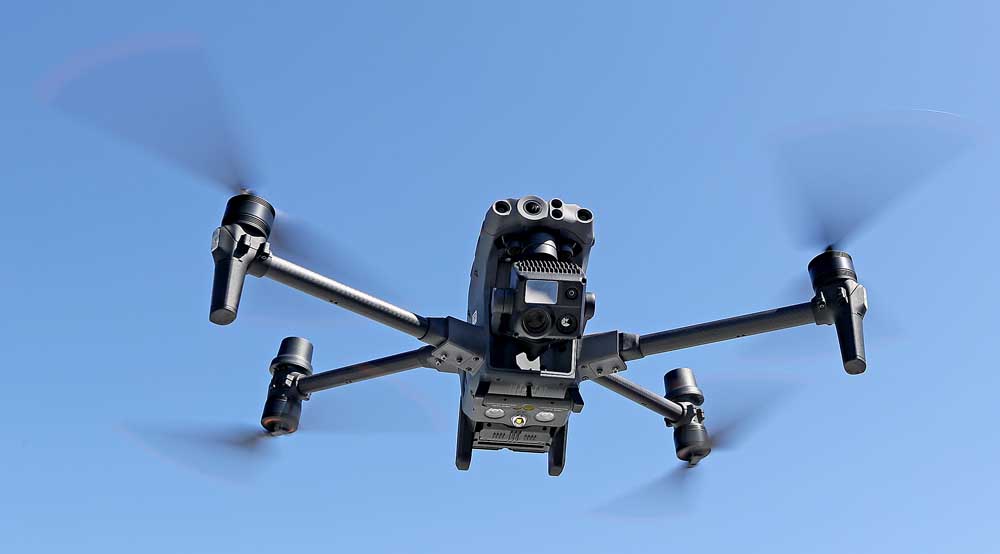Medford police say drones improve safety, but challenges remain
Published 2:00 pm Sunday, May 19, 2024

- A Matrice 30 Series drone is operated at the Medford Police Department in early May.
Still fresh in the mind of Medford Police Department Detective Sgt. Quint Oller is October 2022, when he heard a report of an armed man who had barricaded himself in a warehouse within city limits. The suspect, Daniel Ryan Lee Tiger, then 37, had fled from police in a stolen vehicle during a traffic stop.
The report got his mind racing.
“All I can think about is this guy being up on this elevation being able to kill officers,” Oller said in a recent interview at police headquarters. “So I am just getting there as fast as I can, deploying the drone as fast as I can.”
Oller is one of seven MPD officers who is certified by the Federal Aviation Administration to fly drones, also known as uncrewed aerial vehicles, or UAVs.
Drones, which the MPD has had since September 2022, are becoming a common tool among law enforcement agencies nationwide, according to experts and news reports.
But some agencies, including MPD, are still finding challenges when using UAVs — particularly in Oregon, which Oller described as a “very different” state to operate in when it comes to the use of drones.
“I think most other states are very lenient,” said Oller, supervisor for the department’s Drone Response Team.
The MPD has five drones and is in the process of procuring two more with grant money, according to Oller.
Ranging in size and capabilities, the drones serve MPD in a host of operations, from responding to a crime to search and rescue.
MPD has deployed drones on 84 incidents, according to Oller. He said his agency has not seen a uptick in deployments, mostly because drone use depends on in-progress crimes and the availability of drone pilots.
Oller called drones not only a “force multiplier” for law enforcement, but also a “de-escalator” when it comes to dealing with criminal offenders.
“They’re not aware of what the drone is capable of doing, so they’d rather just surrender to the drone,” Oller said.
The news that his department has drones spread quickly among offenders through word of mouth, he said.
“A lot of times, even when we don’t have (drones) up, they think they’re up,” Oller said.
Medford police must make sure they’re following Part 107 of the code of federal regulations, which pertain to small UAVs. The code states that drones cannot be flown higher than 400 feet above ground level unless a UAV is launched at a higher elevation.
In addition, Oller regularly keeps with him pages of Oregon Revised Statutes that govern law enforcement’s use of drones in the state.
While he is adamant that there is “nothing in ORS that hinders us,” he said the statutes can cause delays for law enforcement’s ability to use drones.
“It would just be nice if they added to ORS to say, ‘Under any lawful law enforcement activity, drones are approved for use,'” Oller said.
Under ORS, a law enforcement agency may operate a UAV if a warrant is issued authorizing its use; the agency has probable cause to believe that a person has committed a crime, is committing a crime or is about to commit a crime; or exigent circumstances exist that make it unreasonable for the agency to obtain a warrant authorizing use of a UAV.
In the case of drug activity, for example, Oller said law enforcement agencies in Oregon would have to make sure a crime was being committed before launching a drone. But agencies in other states, Oller said, could have its drone launched in a similar situation because UAVs are being used for lawful law enforcement activity.
Outside of Oregon, “if you’re conducting lawful surveillance of an area that you have permission to be at, you could already have the drone going and you could be out of view,” Oller said.
Even with Oregon’s “cumbersome laws,” Oller said MPD is able to use drones in a way that is “very beneficial to both law enforcement and the community.”
He stressed that MPD is a proponent of residents’ right to privacy and wants to protect it.
“I can’t just say, ‘Hey, I know a lot of crime goes on at Hawthorne Park. I’m going to go fly a drone 400 feet up in the air and surveil people,” Oller said. “We can’t do that — and that’s good that we can’t do that.”
The October 2022 standoff involving Daniel Ryan Lee Tiger is an incident Otter touts as an example of drones being used effectively.
The drone proved in minutes that Tiger was not on the roof of the warehouse.
“It changes the game when you don’t know if this guy is in an elevated position,” Oller said.
MPD was able to strategize once officers knew Tiger was not on the roof, Oller said.
MPD officers still had to confront Tiger, who fired several rounds at police on the ground and yelled at officers before firing shots inside the warehouse (the building had already been evacuated), according to news reports.
Drones, still in the sky, found Tiger by sensing his body heat, according to Oller.
“From an elevated position, we were able to zoom in and see the suspect, where no one else could see him,” Oller said.
Tiger was arrested without incident hours later. (He later pleaded guilty to the crimes and was sentenced to prison.
Then MPD officers had to find Tiger’s missing firearm inside the warehouse.
“It’s a needle in a haystack,” Oller said. The initial plan was to use 10 to 20 officers working overtime — which would have cost the department tens of thousands of dollars — to look for the weapon. “That was an incredibly daunting task.”
Instead, MPD decided to fly two drones inside the warehouse. The firearm was found after Oller flew his UAV over some boxes.
“Got it wrapped up — boom, we’re done,” Oller said.






